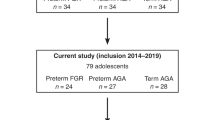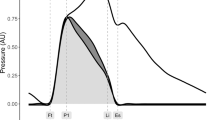Abstract
Preterm birth might induce permanent changes in vascular structure and function as well as in blood pressure. To elucidate this hypothesis and underlying mechanisms in girls born before term, the authors correlated neonatal data, including estradiol levels, with vascular function and structure and with blood pressure after puberty. In a case-control study design, 34 girls born before term and 32 gender- and age-matched control infants born at term were included. Pulse wave analysis was used to determine aortic pressure profiles and overall arterial compliance. Stiffness of the carotid artery and abdominal aorta was measured with ultrasonography. Pulse wave velocity in the forearm was measured with photoplethysmography. A laser Doppler technique was used to determine skin perfusion before and after transdermal delivery of acetylcholine, an endothelium-dependent vasodilator. It was found that preterm girls had significantly higher brachial and aortic blood pressure, a narrower but less stiff abdominal aorta, and lower peripheral skin blood flow than did control infants. Augmentation index, carotid stiffness, pulse wave velocity, endothelium-dependent vasodilatation, and heart rate were similar in the two groups. In the preterm group, blood pressure and vascular functions showed no association with intrauterine growth retardation or neonatal estradiol levels. In conclusion, preterm girls have higher blood pressure and an increased resistance in the vascular tree after puberty. These findings may have implications for future cardiovascular risk in the growing adult population surviving preterm birth.
Similar content being viewed by others
Log in or create a free account to read this content
Gain free access to this article, as well as selected content from this journal and more on nature.com
or
Abbreviations
- Ach:
-
acetylcholine
- AGA:
-
appropriate for gestational age
- AI:
-
augmentation index
- BMI:
-
body mass index
- BP:
-
blood pressure
- CV:
-
coefficient of variation
- PU:
-
perfusion unit
- PWV:
-
pulse wave velocity
- SGA:
-
small for gestational age
References
Kistner A, Jacobson L, Jacobson SH, Svensson E, Hellstrom A 2002 Low gestational age associated with abnormal retinal vascularization and increased blood pressure in adult women. Pediatr Res 51: 675–680
Norman M, Martin H 2003 Preterm birth attenuates association between low birth weight and endothelial dysfunction. Circulation 108: 996–1001
Siewert-Delle A, Ljungman S 1998 The impact of birth weight and gestational age on blood pressure in adult life: a population-based study of 49-year-old men. Am J Hypertens 11: 946–953
Kistner A, Celsi G, Vanpee M, Jacobson SH 2000 Increased blood pressure but normal renal function in adult women born preterm. Pediatr Nephrol 15: 215–220
Irving RJ, Belton NR, Elton RA, Walker BR 2000 Adult cardiovascular risk factors in premature babies. Lancet 355: 2135–2136
Leon DA, Johansson M, Rasmussen F 2000 Gestational age and growth rate of fetal mass are inversely associated with systolic blood pressure in young adults: an epidemiologic study of 165,136 Swedish men aged 18 years. Am J Epidemiol 152: 597–604
Lundgren EM, Cnattingius HM, Jonsson GB, Tuvemo TH 2001 Linear catch-up growth does not increase the risk of elevated blood pressure and reduces the risk of overweight in males. J Hypertens 19: 1533–1538
Doyle LW, Faber B, Callanan C, Morley R 2003 Blood pressure in late adolescence and very low birth weight. Pediatrics 111: 252–257
Gluckman PD, Hanson MA 2004 Developmental origins of disease paradigm: a mechanistic and evolutionary perspective. Pediatr Res 56: 311–317
Kaijser M, Jacobsen G, Granath F, Cnattingius S, Ekbom A 2002 Maternal age, anthropometrics and pregnancy oestriol. Paediatr Perinat Epidemiol 16: 149–153
Sedin G, Bergquist C, Lindgren PG 1985 Ovarian hyperstimulation syndrome in preterm infants. Pediatr Res 19: 548–552
Virdis A, Ghiadoni L, Pinto S, Lombardo M, Petraglia F, Gennazzani A, Buralli S, Taddei S, Salvetti A 2000 Mechanisms responsible for endothelial dysfunction associated with acute estrogen deprivation in normotensive women. Circulation 101: 2258–2263
Mendelsohn ME, Karas RH 1994 Estrogen and the blood vessel wall. Curr Opin Cardiol 9: 619–626
Miyamoto N, Mandai M, Takagi H, Suzuma I, Suzuma K, Koyama S, Otani A, Oh H, Honda Y 2002 Contrasting effect of estrogen on VEGF induction under different oxygen status and its role in murine ROP. Invest Ophthalmol Vis Sci 43: 2007–2014
Rowland NE, Fregly MJ 1992 Role of gonadal hormones in hypertension in the Dahl salt-sensitive rat. Clin Exp Hypertens A 14: 367–375
Dong C, Yoon W, Goldschmidt-Clermont PJ 2002 DNA methylation and atherosclerosis. J Nutr 132: 2406S–2409S
Marsal K, Persson PH, Larsen T, Lilja H, Selbing A, Sultan B 1996 Intrauterine growth curves based on ultrasonically estimated foetal weights. Acta Paediatr 85: 843–848
Pauca AL, O'Rourke MF, Kon ND 2001 Prospective evaluation of a method for estimating ascending aortic pressure from the radial artery pressure waveform. Hypertension 38: 932–937
Oliver JJ, Webb DJ 2003 Noninvasive assessment of arterial stiffness and risk of atherosclerotic events. Arterioscler Thromb Vasc Biol 23: 554–566
Martin H, Hu J, Gennser G, Norman M 2000 Impaired endothelial function and increased carotid stiffness in 9-year-old children with low birthweight. Circulation 102: 2739–2744
Loukogeorgakis S, Dawson R, Philips N, Martyn CN, Greenwald SE 2002 Validation of a device to measure arterial pulse wave velocity by a photo-plethysmographic method. Physiol Meas 23: 581–596
Hansell J, Henareh L, Agewall S, Norman M 2004 Non-invasive assessment of endothelial function: relation between vasodilatory responses in skin microcirculation and brachial artery. Clin Physiol Funct Imaging 24: 317–322
Huxley RR, Shiell AW, Law CM 2000 The role of size at birth and postnatal catch-up growth in determining systolic blood pressure: a systematic review of the literature. J Hypertens 18: 815–831
Singhal A, Cole TJ, Lucas A 2001 Early nutrition in preterm infants and later blood pressure: two cohorts after randomised trials. Lancet 357: 413–419
Langille BL, Brownlee RD, Adamson SL 1990 Perinatal aortic growth in lambs: relation to blood flow changes at birth. Am J Physiol 259: H1247–H1253
Berenson GS, Srinivasan SR, Bao W, Newman WP 3rd, Tracy RE, Wattigney WA 1998 Association between multiple cardiovascular risk factors and atherosclerosis in children and young adults. The Bogalusa Heart Study. N Engl J Med 338: 1650–1656
Farrar DJ, Bond MG, Riley WA, Sawyer JK 1991 Anatomic correlates of aortic pulse wave velocity and carotid artery elasticity during atherosclerosis progression and regression in monkeys. Circulation 83: 1754–1763
Martin H, Gazelius B, Norman M 2000 Impaired acetylcholine-induced vascular relaxation in low birth weight infants: implications for adult hypertension?. Pediatr Res 47: 457–462
Leeson CP, Whincup PH, Cook DG, Mullen MJ, Donald AE, Seymour CA, Deanfield JE 2000 Cholesterol and arterial distensibility in the first decade of life: a population-based study. Circulation 101: 1533–1538
Singhal A, Kattenhorn M, Cole TJ, Deanfield J, Lucas A 2001 Preterm birth, vascular function, and risk for atherosclerosis. Lancet 358: 1159–1160
Antonios TF, Singer DR, Markandu ND, Mortimer PS, MacGregor GA 1999 Rarefaction of skin capillaries in borderline essential hypertension suggests an early structural abnormality. Hypertension 34: 655–658
Ijzerman R, van Weissenbruch MM, Voordouw JJ, Yudkin JS, Serne EH, Delemarre-van de Waal HA, Stehouwer CD 2002 The association between birth weight and capillary recruitment is independent of blood pressure and insulin sensitivity: a study in prepubertal children. J Hypertens 20: 1957–1963
Irving RJ, Shore AC, Belton NR, Elton RA, Webb DJ, Walker BR 2004 Low birth weight predicts higher blood pressure but not dermal capillary density in two populations. Hypertension 43: 610–613
Leeson CP, Whincup PH, Cook DG, Donald AE, Papacosta O, Lucas A, Deanfield JE 1997 Flow-mediated dilation in 9- to 11-year-old children: the influence of intrauterine and childhood factors. Circulation 96: 2233–2238
Cheung YF, Wong KY, Lam BC, Tsoi NS 2004 Relation of arterial stiffness with gestational age and birth weight. Arch Dis Child 89: 217–221
Lanne T, Hansen F, Mangell P, Sonesson B 1994 Differences in mechanical properties of the common carotid artery and abdominal aorta in healthy males. J Vasc Surg 20: 218–225
Reynolds JW, Barnhart BJ, Carlson CV 1986 Feto-placental steroid metabolism in growth retarded human fetuses. Pediatr Res 20: 166–168
Author information
Authors and Affiliations
Corresponding author
Additional information
Supported by the Swedish Research Council (projects 71P-14158, 73VX-14729), Swedish Heart Lung Foundation, Karolinska Institute Research Foundations, Sällskapet Barnavård, and HRH Crown Princess Lovisa's Memorial Fund.
Rights and permissions
About this article
Cite this article
Bonamy, AK., Bendito, A., Martin, H. et al. Preterm Birth Contributes to Increased Vascular Resistance and Higher Blood Pressure in Adolescent Girls. Pediatr Res 58, 845–849 (2005). https://doi.org/10.1203/01.PDR.0000181373.29290.80
Received:
Accepted:
Issue date:
DOI: https://doi.org/10.1203/01.PDR.0000181373.29290.80
This article is cited by
-
High protein intake on later outcomes in preterm children: a systematic review and meta-analysis
Pediatric Research (2024)
-
Higher blood pressure in adolescent boys after very preterm birth and fetal growth restriction
Pediatric Research (2023)
-
Premature differentiation of nephron progenitor cell and dysregulation of gene pathways critical to kidney development in a model of preterm birth
Scientific Reports (2021)
-
Long-term metabolic risk among children born premature or small for gestational age
Nature Reviews Endocrinology (2017)
-
Preterm arteries in childhood: dimensions, intima-media thickness, and elasticity of the aorta, coronaries, and carotids in 6-y-old children born extremely preterm
Pediatric Research (2017)



